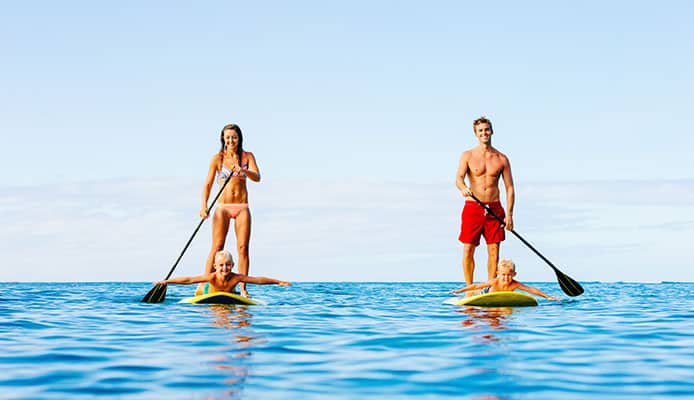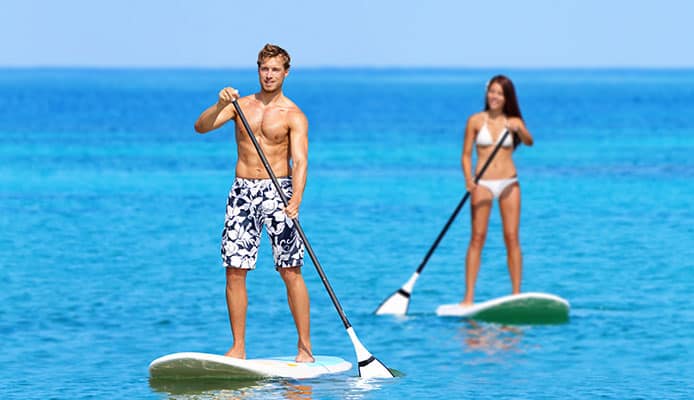
Paddleboarding has been on a steady rise over recent years, with many people taking to the oceans, seas, rivers, and lakes. And why not? There are plenty of amazing benefits for paddleboarding. Not only does it help build muscle and increase your core strength but it is also thrilling and downright fun. These and many other reasons for trying paddle boarding.
However, it’s easy to forget that paddleboarding also has its fair share of risks and to ensure paddleboard safety, certain rules need to be observed. While it’s crucial to learn how to paddle a stand up paddleboard before you can get on one, This paddleboard safety guide looks at the 10 things you should never do when paddleboarding.
Let’s begin.
1. Never leave the paddleboard out in the sun
Sunny days are the best days to enjoy time on a paddleboard, no doubt. But always ensure that your paddleboard is kept away from direct sunlight when not in use.
Leaving it out in the sun for extended periods will not only fade the pretty colors but could cause the construction to overheat and crack.
This makes the paddleboard less sturdy which could put you at risk of falling into the water. It is not the best thing especially when paddleboarding further out in deep waters.
2. Not cleaning the paddleboard
Another mistake that many people make is forgetting to clean their paddleboard after use. Especially after being out in salty water, cleaning the paddleboard is crucial. The salty water could eat away at the integrity of your paddleboard which reduces its durability over time.
The best way to clean your paddleboard is to use fresh clean water and a soft cleaner. Then use a towel to wipe off the surface of the board before storing it in a place away from direct sunlight and ready for the next time you want to head out to sea.
3. Lack of proper storage
Many people don’t know how to store the paddleboard when not in use. As a rule of thumb, the paddleboard should be kept away from places that can get hot. Under the shed is certainly out of question as to the heat from the sun can get through and damage the board.
In the garage, in the house, or anywhere that is cool and away from direct sunlight will work. Just make sure that the paddleboard is also kept in a secure place where it will not fall and get damaged.
4. Paddleboarding in rocky waters
Before using your paddleboard on the water, you should bring with you all the paddleboarding accessories and have a rough idea of the depth to avoid damaging your paddleboard. Shallow waters could have rocks closer to the surface that can scratch and damage the epoxy paddleboard.
And the same can be said about inflatable paddleboards. The fins and lower side can get scratched to the point where you might need to replace the board
5. Improper transportation

Learning how to transport your stand up paddleboard is crucial. The paddleboard is most likely to get damaged during transportation. It could fall off the roof of the car or may simply not be secured properly when heading out to the lake or the ocean. A good paddle board car roof rack will help secure it tightly.
With epoxy paddleboards, ensure that it is strapped tightly and securely on the roof of the car. Inflatable paddleboards should be deflated during transportation and stored inside its bag.
6. Paddleboarding in unfamiliar waters
While it’s perfectly fine to try out a new destination with your paddleboard, it’s important to first scan the water and check for any rocks, rapids, or waterfalls.
Not knowing exactly where you are paddleboarding could expose you to some serious safety risks. So, do your homework and always be aware of the type of waters you plan to paddleboarding in.
7. Not using a leash
It might sound trivial but a leash is absolutely important when standing up paddleboarding. It keeps the paddleboard close to you at all times. If for example, you were to fall into the water, even a slight current could push the paddleboard further away from you.
This would cause you to expend energy swimming after the board. However, with the leash, you can quickly recover and get back on top of the board. The leash also prevents the paddleboard from hitting other paddleboarders around you.
8. Not checking the weather conditions
The weather conditions can change fast. What started as a warm and pleasant day could quickly change into fast winds and a strong current in a matter of minutes. For SUP safety, make sure to check the weather forecasts to be able to plan.
When you head out to the river, always begin with the hardest part of your leg. When it’s time to head back home, it will be much easier to paddleboard compared to when you started.
By flowing with the wind and current as you finish your paddle boarding, you can quickly and safely get to where you want to be.
If you start your paddle boarding and notice that it is easy to paddle through the water, this could be due to going in the direction of the current or the wind. Always check for this. Being aware of the weather forecasts is one of the most important paddleboard safety measures and will help you spot a storm developing and take the necessary precautions. You may need to cut short your paddleboarding adventure and head back home.
9. Not checking the water temperature
As you keep a watchful eye and a keen ear on the weather forecasts, always make sure that you are dressed right when paddle boarding in cold water. Falling in could put you in a serious state of hypothermia.
You might also like: Learn Romantic Things To Do on a Paddle Board
A personal floatation device will at least help you to float and PFD vests can also help to keep your body warm when in the water.
10. Not knowing how to self-rescue
You may have used a paddleboard before and you may know how to swim, but one of the most important skills to have is knowing how to fall and how to quickly get back on your paddleboard.
If you have never fallen off your paddleboard, you certainly do not want to practice getting back on when you are in the sea.
Practice falling and quickly getting back on the paddleboard before heading out to the lake or ocean. That way, in case you find yourself in a tricky situation, you will know exactly what to do.
Also, taking paddleboarding lessons will help you gain plenty of valuable information. This will help maintain paddleboard safety when you are out on the water. Coupled with showing you how to quickly get back on your paddleboard, you will also learn how to pick the best locations as well as which waters to avoid.
Another important skill that you are going to gain is how to paddle correctly and efficiently. This can be a lifesaver when you find yourself in a strong current or when the winds suddenly pick up.
Globo Surf Overview
Being on a paddleboard can be great fun. You can cruise along the surface of the water at a moderate pace as you enjoy the sights and scenery around you. However, to ensure SUP safety, the ten tips we’ve laid out for you above will ensure you make the most of your paddleboarding adventure.
Paddling paddle Board Guides:
- Winter Paddling Guide: How To Paddle Board In Cold Weather?
- What Is SUP (Standup Paddleboarding)?
- Plastic VS Fiberglass Paddleboard Comparison Guide
- Fiberglass SUP VS Inflatable SUP Comparison Guide
- 10 Reasons Why You Should Try Paddle Boarding
- All The Parts Of A Standup Paddle Board
Paddling Paddle boards Reviews:

